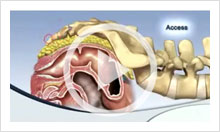AxiaLIF®
AxiaLIF® surgery refers to axial lumbar interbody fusion, an alternative to traditional back surgery. Many people with degenerative disc disease, spinal stenosis, or low-grade spondylolisthesis in the lower lumbar region (L5-S1) are treated surgically. These operations may be open procedure done under general anesthesia or they may be done as minimally invasive surgery (MIS) using an endoscope and a very small incision.
Videos: These videos show and explain the AxiaLIF 1-level and 2-level procedures:


The AxiaLIF® device is a small threaded rod. In the AxiaLIF® procedure, this little rod is implanted after the damaged disc is removed. This stabilizes the spine and may reduce pain.
Where is L5-S1?
The spine extends from the base of the skull to the tailbone. The lower region of the spine is called the lumbar region. L5 refers to the very last vertebrae of the lumbar region. L5 connects to the first bone of the sacrum or S1. The sacrum forms the very base of the spine and is actually part of the pelvis.
Problems with the L5-S1 area may cause pain in the lower back, buttocks, and leg, and can trigger neurological symptoms such as numbness, tingling, or weakness in the legs.
Who is a Good Candidate for AxiaLIF® Surgery?
If the problems with the L5-S1 vertebrae are mild, non-surgical treatments such as medication or physical therapy may bring relief. If symptoms get progressively worse and become severe, if neurological problems are severe, or if there is instability in the spinal column, surgery may be recommended.
AxiaLIF® Surgery
This surgery is often a minimally invasive procedure, meaning only a small incision is made near the lower spine. Using an endoscope or tube with attached light and camera, the surgeon removes the damaged disc. To fill up the space left vacant by the disc, the surgeon packs the area with bone graft which helps stimulate fusion. Then the surgeon installs the AxiaLIF® short threaded rod by placing it between L5 and S1 to provide proper spacing. The rod restores lost disc height and stabilizes the spine.
What to Expect from AxiaLIF® Surgery
Prior to surgery, the physician will discuss the potential risks and benefits of surgery and what to expect in an individual case. Npt all patients are appropriate candidates for surgery and surgery is not necessary in all patients with back problems. The surgical procedure for AxiaLIF® may be done on an outpatient basis or require a short hospital stay. Some postoperative pain is to be expected.
The physician will also provide instructions for at home care including any activity restrictions and how to care for the incision site. After surgery, a follow-up visit to the doctor is usually required so he or she can monitor wound healing and progress.
